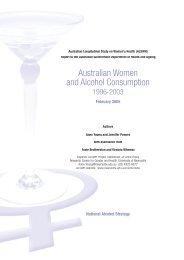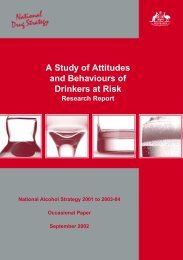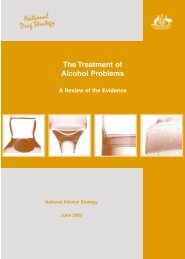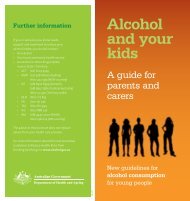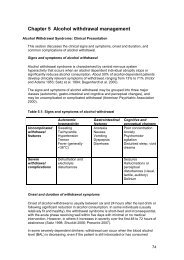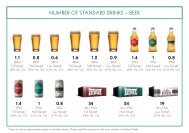Chapter 3 Screening, assessment and treatment planning - Alcohol
Chapter 3 Screening, assessment and treatment planning - Alcohol
Chapter 3 Screening, assessment and treatment planning - Alcohol
You also want an ePaper? Increase the reach of your titles
YUMPU automatically turns print PDFs into web optimized ePapers that Google loves.
According to the professional background <strong>and</strong> skills of the health professional, allpatients should be assessed regarding their physical health. If there are any activemedical issues, it is appropriate to encourage the patient to see his/her GP or othermedical practitioner. If there are no significant symptoms but the alcohol historyplaces the patient at risk of medical illness, medical referral for physical examination<strong>and</strong> blood tests should also be recommended. Medical practitioners should conduct athorough <strong>assessment</strong>, including history, examination <strong>and</strong> clinical investigations.Physical examination should at least assess signs intoxication or withdrawal, signs ofliver disease, vital signs (temp, blood pressure, pulse) <strong>and</strong> screen for organic braindamage (Miller et al. 1988).There is demonstrated value in the simple act of feeding back to the patient theresults of the medical examination <strong>and</strong> any clinical investigations. For example,discussion about the implications of abnormal liver function tests has been shown toreduce subsequent alcohol consumption.The Drinker’s Check-up is an example of acomputer software program that relies heavily on this motivating function of feedingback objective information (Hester et al. 2005; Miller et al. 1988).The advantages of feedback are less clear when the medical tests show normalresults. However, the whole <strong>assessment</strong> process should allow patients to assessaccurately the degree of their alcohol- related problems <strong>and</strong> normal medical resultsshould not detract from this process. The issue of normal results can be looked atwithin the context of a clinical interaction <strong>and</strong> is further discussed in the motivationalinterviewing material in <strong>Chapter</strong> 6: Psychosocial interventions.Recommendation3.14 Assessment for alcohol-related physicalhealth problems should be routinely conducted.A medical practitioner should assess patients atrisk of physical health problems.Strength ofrecommendationSLevel ofevidenceAssessing psychological <strong>and</strong> psychiatric disorders<strong>Alcohol</strong> use disorders are associated with a range of mental health problems. It istherefore critical to assess for comorbid disorders <strong>and</strong> symptoms, particularlydepression <strong>and</strong> anxiety symptoms. A range of short questionnaires is available forassessing mental health disorders.Around one in five (20 percent) Australians with alcohol dependence also have ananxiety disorder, whilst 24 percent have an affective (mood) disorder. Heavy alcoholuse is also associated with other substance misuse, greater levels of psychologicaldistress <strong>and</strong> high levels of psychosis (Teesson et al. 2000; Cleary et al. 2008).Patients with post-traumatic stress disorder (PTSD) also have increased rates ofalcohol-related disorders, <strong>and</strong> both of these may also be associated with a range ofpersonality disorders (American Psychiatric Asscoation 2000). However, care mustbe taken not to make a personality disorder diagnosis based solely on behavioursthat are a result of alcohol intoxication or withdrawal.Thus, it is critical to assess for comorbid disorders <strong>and</strong> symptoms, <strong>and</strong> suicidalideation. Referral for further specialist <strong>assessment</strong> may be required if significantmental problems are suspected.32



